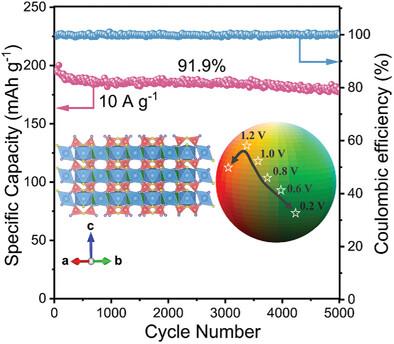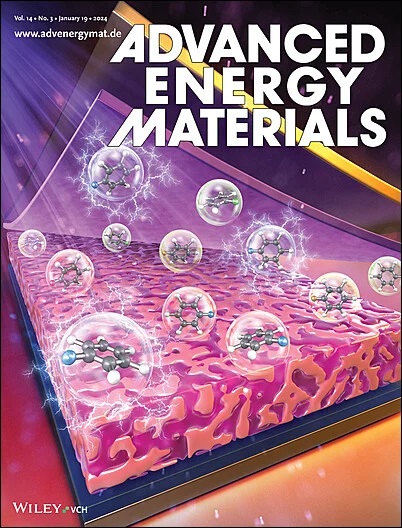A Multi-Colored, Structure-Tolerant Vanadate Cathode for High-Performance Aqueous Zinc-Ion Batteries
IF 24.4
1区 材料科学
Q1 CHEMISTRY, PHYSICAL
引用次数: 0
Abstract
Vanadium-based cathode materials for aqueous zinc-ion batteries (AZIBs) have attracted much attention in large-scale energy storage devices yet their unsatisfactory cyclic stability and slow diffusion rate of Zn2+ ions during insertion and extraction hinder further commercial applications. Therefore, the development of vanadium-based cathode materials with stable crystal structures and fast Zn2+ storage remains challenging. Herein, Na2CaV4O12 (NCVO) nanowires are reported as a promising cathode of excellent electrochemical performance in AZIBs, simultaneously rendering high specific capacity (443.2 mAh g−1 at 0.1 A g−1) and high average voltage plateau (0.91 V) with impressive energy density (403.3 Wh kg−1) and power density (1533 W kg−1). As NCVO features a unique open crystal structure with alternately arranged inactive layers ([NaO6] and [CaO8] polyhedra) and active layers ([VO4] tetrahedra), the expansion of the [VO4] tetrahedra during Zn2+ insertion is well balanced by the contraction of the inactive layer, thus enabling remarkable long-term cycling stability (91.9% and 80% capacity retention after 5000 and 10 000 cycles at 10 A g−1, respectively). With the electrochromic property of the NCVO cathode, the AZIB can further be used for adaptive camouflage under a range of scenarios, shedding light on the future development of high-performance cathodes for AZIBs.

一种用于高性能水锌离子电池的多色、耐结构钒酸盐阴极
钒基水基锌离子电池(AZIBs)正极材料在大规模储能装置中受到广泛关注,但其循环稳定性不理想,在插入和提取过程中Zn2+离子的扩散速度慢,阻碍了其进一步的商业应用。因此,开发具有稳定晶体结构和快速存储Zn2+的钒基正极材料仍然是一个挑战。在此,Na2CaV4O12 (NCVO)纳米线被报道为AZIBs中具有优异电化学性能的极具前景的阴极,同时具有高比容量(在0.1 ag−1时为443.2 mAh g−1)和高平均电压平台(0.91 V),令人印象印象的能量密度(403.3 Wh kg−1)和功率密度(1533 W kg−1)。由于NCVO具有独特的开放晶体结构,非活性层([NaO6]和[CaO8]多面体)和活性层([VO4]四面体)交替排列,在Zn2+插入过程中,[VO4]四面体的膨胀被非活性层的收缩很好地平衡,从而实现了显著的长期循环稳定性(在10a g−1下循环5000次和10000次后容量分别保持91.9%和80%)。凭借NCVO阴极的电致变色特性,AZIB可以在一系列场景下进一步用于自适应伪装,为AZIB高性能阴极的未来发展提供了光明。
本文章由计算机程序翻译,如有差异,请以英文原文为准。
求助全文
约1分钟内获得全文
求助全文
来源期刊

Advanced Energy Materials
CHEMISTRY, PHYSICAL-ENERGY & FUELS
CiteScore
41.90
自引率
4.00%
发文量
889
审稿时长
1.4 months
期刊介绍:
Established in 2011, Advanced Energy Materials is an international, interdisciplinary, English-language journal that focuses on materials used in energy harvesting, conversion, and storage. It is regarded as a top-quality journal alongside Advanced Materials, Advanced Functional Materials, and Small.
With a 2022 Impact Factor of 27.8, Advanced Energy Materials is considered a prime source for the best energy-related research. The journal covers a wide range of topics in energy-related research, including organic and inorganic photovoltaics, batteries and supercapacitors, fuel cells, hydrogen generation and storage, thermoelectrics, water splitting and photocatalysis, solar fuels and thermosolar power, magnetocalorics, and piezoelectronics.
The readership of Advanced Energy Materials includes materials scientists, chemists, physicists, and engineers in both academia and industry. The journal is indexed in various databases and collections, such as Advanced Technologies & Aerospace Database, FIZ Karlsruhe, INSPEC (IET), Science Citation Index Expanded, Technology Collection, and Web of Science, among others.
 求助内容:
求助内容: 应助结果提醒方式:
应助结果提醒方式:


